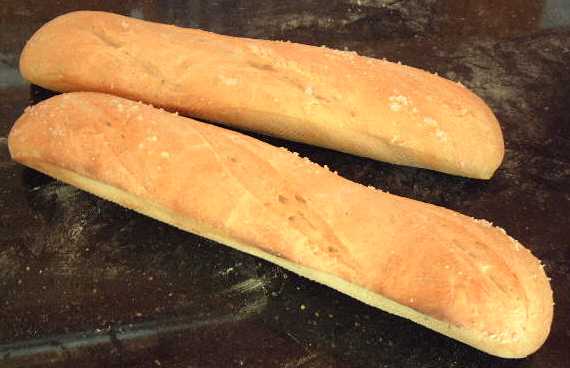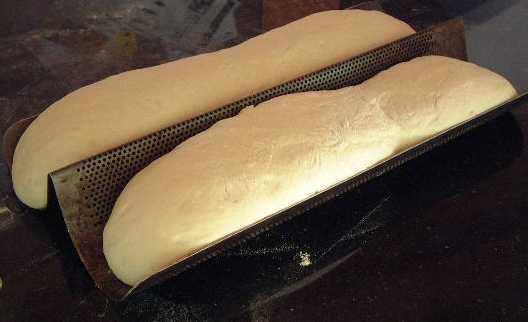- Projects
- Writing
- Images
- Travel
- My Recipes
- Mom's Recipes
- Dad's Cards
Marc's Basic Bread Recipe

This recipe is adapted from Bernhard Clayton's book with additional tips that I've learned from experience. This is a good, basic baguette or battard style loaf.
6 cups good bread flour
1/4 cup whole wheat
flour
2 packages dried yeast (if using quick rising halve the rising times)
2 cups water
1 tablespoon salt
Optional stuff that is
nice to have:
KitchenAid mixer
French bread pans
gray sea salt
Mix 4 cups of the white
bread flour, the whole wheat flour, and the yeast together in a mixing
bowl (a KitchenAid is excellent for this step).
Heat the water to between 120° and 130° F and add it to the
flour and yeast while the mixer is going at slow speed.
Optional step: Mix the
dough for a minute, then shut off the mixer and push any dough down
the sides of the bowl. Leave it sit for 10 minutes to an hour before
proceeding. This will let the yeast ferment for a bit and produce
a smooth, elastic dough.
Mix the dough for 10 minutes on slow or near slowest speed.
Disolve the salt in the minumum amount of water (no more than 2 tablespoons
of water) and add to the dough mixture.
With the mixer still going,
add as much of the remaining 2 cups of flour as you can. You probably
won't be able to add more than a cup.
At this point, the dough is too much for even my beefy KitchenAid,
so I cover a kneading surface with the remaining flour andI turn the
dough out onto it.
Knead for 10 minutes, frequently
throwing the dough down hard on the counter.
Add as much flour as you judge necessary, but the dough will still be slightly tacky.
Put in a large bowl and cover with a wet cloth. Let rise until tripled in volume (about 2 hours).
IMPORTANT: Yeast prefers 80° F and high humidity. I had dramatically better results doing the following:
- I
preheat the oven to the lowest setting while kneading the dough.
Then I switch it off just prior to putting the dough into rise.
If you live somewhere where it's 80° then you probably don't
have to do this step.
- I boil water and put it in a pan in the oven. This possibly makes the biggest difference.
Punch down the dough and let rise again until doubled (about 1 hour).
Turn the dough out and knead gently for a minute to remove the air bubbles.
Let rest for 5 minutes (I usually skip this step).
Divide the dough up into 2 or 3 parts depending whether you are making 3 baguettes or 2 battards.
Fold the dough onto itself so that the surface is tensioned and smooth.
Roll the dough using the palm of your hand until it is the desired length.
Lay the dough out onto the pan you will use to bake them in. I have had good luck with the curved 2 and 3 French loaf pans.
Put them back in the oven to proof (about 30 minutes or more)
IMPORTANT: Proofing is key. It's easy to get impatient at this point and want to get the loaves in the oven to bake, but waiting until the loaves have risen properly accomplishes two things:
- The
loaves will have a fuller shape and airy interior,
- The surface will have a chance to dry out, making the crust light and crunchy.

Once proofing
is complete, remove the dough and turn the oven on to 450° F.
Boil some more water. Once the oven is hot, pour the boiling water
in the pan already in the oven.
WARNING:
Pouring boiling water into an even hotter oven will produce superheated
steam. Wear an oven mitt and stand back.
Slash the loaf diagonally in several places along its length. In my experience, this is best accomplished with a very, very sharp knife. It is often recommended to use a razor blade or an X-acto knife, but I've had luck with neither. Instead I use a Japanese chef's knife, and draw the blade cleanly across the loaf.
Don't be afraid to cut pretty deep (1/4 to 1/2 inch). The reason for doing this is to provide a way for the dough to rapidly expand once the air pockets within it are exposed to the high temperature oven.
Brush the outside of the loaf with a salt-water mixture. I like to use really large-crystalled grey sea salt, brushing it on so that some chunks are left whole on the surface. It is important to do this after the slash marks have been made, otherwise the surface will be wet and sticky, and draw with the knife blade.
Pop the bread in the steamy hot oven and bake for 20 to 30 minutes.
IMPORTANT: Only with experience will you get to know your particular oven. The common test for doneness in a loaf of bread is to tap it on the bottom and hear if it sounds hollow. Well I don't know about you, but once I have a loaf of freshly baked bread in my hand they all sound hollow enough to eat.
Many
is the time that I've pulled a loaf out and thought it was done, only
to find it too moist and chewy inside.
Here are some observations from my own oven experiences that might
help you figure out how to best bake bread in it:
- I
used to put the tray of boiling water under the bread, but I think
this led to too much moisture to cause the loaf to cook too slowly
on the bottom.
- I
bake my bread on the bottom most rack, and rotate it front-to-back
after about 15 minutes, because the back is hotter than the front.
- If,
near the end, it seems to be too brown on the bottom, I move it
to the top rack to finish.
- I
have learned to wait until the crust is truely golden brown, with
some tinges of darker brown before I remove it. This particular
bread is wet enough that you will burn the crust before the bread
will be dry (this is not true for all breads).
When the bread is done, remove it from the oven and let cool. Try not to eat it all immediately.
Putting day-old bread in a 350° oven for a few minutes will restore it to a crispy crust.
